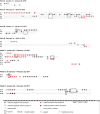Secondary attack rates from asymptomatic and symptomatic influenza virus shedders in hospitals: Results from the TransFLUas influenza transmission study
- PMID: 33952361
- PMCID: PMC8961411
- DOI: 10.1017/ice.2021.112
Secondary attack rates from asymptomatic and symptomatic influenza virus shedders in hospitals: Results from the TransFLUas influenza transmission study
Abstract
Objective: Nosocomial transmission of influenza is a major concern for infection control. We aimed to dissect transmission dynamics of influenza, including asymptomatic transmission events, in acute care.
Design: Prospective surveillance study during 2 influenza seasons.
Setting: Tertiary-care hospital.
Participants: Volunteer sample of inpatients on medical wards and healthcare workers (HCWs).
Methods: Participants provided daily illness diaries and nasal swabs for influenza A and B detection and whole-genome sequencing for phylogenetic analyses. Contacts between study participants were tracked. Secondary influenza attack rates were calculated based on spatial and temporal proximity and phylogenetic evidence for transmission.
Results: In total, 152 HCWs and 542 inpatients were included; 16 HCWs (10.5%) and 19 inpatients (3.5%) tested positive for influenza on 109 study days. Study participants had symptoms of disease on most of the days they tested positive for influenza (83.1% and 91.9% for HCWs and inpatients, respectively). Also, 11(15.5%) of 71 influenza-positive swabs among HCWs and 3 (7.9%) of 38 influenza-positive swabs among inpatients were collected on days without symptoms; 2 (12.5%) of 16 HCWs and 2 (10.5%) of 19 inpatients remained fully asymptomatic. The secondary attack rate was low: we recorded 1 transmission event over 159 contact days (0.6%) that originated from a symptomatic case. No transmission event occurred in 61 monitored days of contacts with asymptomatic influenza-positive individuals.
Conclusions: Influenza in acute care is common, and individuals regularly shed influenza virus without harboring symptoms. Nevertheless, both symptomatic and asymptomatic transmission events proved rare. We suggest that healthcare-associated influenza prevention strategies that are based on preseason vaccination and barrier precautions for symptomatic individuals seem to be effective.
Figures


References
Publication types
MeSH terms
LinkOut - more resources
Full Text Sources
Other Literature Sources
Medical

